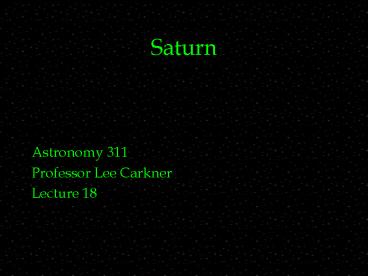Saturn - PowerPoint PPT Presentation
1 / 23
Title: Saturn
1
Saturn
- Astronomy 311
- Professor Lee Carkner
- Lecture 18
2
Which of the following is a major component of
Jupiters clouds?
- Water
- Ammonia
- Molecular hydrogen
- a and b only
- a, b, and c
3
In what region does Jupiter generate its strong
magnetic field?
- Rock/ice core
- Liquid metallic hydrogen mantle
- Molecular hydrogen atmosphere
- Dust ring
- Alternating cloud bands
4
Saturn -- King of the Titans
- He was overthrown by Jupiter who became king of
the gods - Saturns symbol is the sickle
5
Viewing Saturn from Earth
- First viewed through a telescope by Galileo
- Modern telescopes reveal a series of rings and
cloud patterns in Saturns atmosphere
6
Saturn Facts
- Size 9.5 Earth diameters
- Orbit 9.5 AU
- Description smaller, more distant Jupiter with
rings
7
Viewing Saturn from Space
- Hubble Space Telescope has provided many images
- Orbiting Saturn to study it long term
- Dropped a probe (Huygens) into Titans atmosphere
8
Path of Cassini
9
Saturns Atmosphere
- Saturn has belts, zones, ovals and storms, but
they are less distinct than on Jupiter - Colors tend to be yellow, white and brown
- Saturn sometimes has storms that burst up from
below
10
Composition of Atmosphere
- Top layer of Ammonia (NH3)
- Middle layer of Ammonium Hydrosulfide (NH4SH)
- We dont see all of the layers as clearly as we
do on Jupiter
11
Saturns Dullness
- The temperature of Saturns atmosphere increases
more slowly with depth than Jupiter because - Due to weaker gravity the layers are more spread
out - As a result
- Upper layers obscure the deeper layers
12
Saturn and Jupiters Atmospheric Structure
13
Saturns Heat
- Saturn is smaller than Jupiter and should have
radiated much of its heat away by now - Theory the helium condensed into droplets and
fell towards the core liberating gravitational
energy - Calculations seem to support this
14
Saturns Interior
- Saturn is also the most oblate planet
- The density is low due to a much smaller liquid
metallic hydrogen mantle - Saturn has a magnetosphere but it is not as
strong as Jupiters - Due to slower rotation, less liquid hydrogen and
blocking of charged particles by the rings
15
Internal Structure of Jupiter and Saturn
16
HST Views the Rings Edge-On
17
Rings and Tides
- This is the region where the tidal force pulling
the material apart is stronger than the
gravitational force holding it together
18
Structure of the Rings
- Rings are separated by gaps or divisions with
relatively few particles - The size and composition of particles vary from
ring to ring - F ring has many small, dark particles
19
Diagram of Saturns Rings
20
Moons and the Rings
- Several moons have orbits within the rings
- Moons may also be a source of ring material
- Examples of moons effecting the rings
- The Encke gap has a small moon, Pan, in it
21
Next Time
- Read Chapter 13.1-13.6
22
Summary
- Saturn is the second largest planet and the
second closest gas giant to Earth - Saturn is similar to Jupiter with key exceptions
mostly due to less mass and smaller gravity - cloud layers are more spread out in depth
- less distinct cloud bands
- larger core
- less liquid metallic hydrogen
23
Summary Rings
- Made up of many distinct rings and ringlets
- Composed mostly of icy particles of various sizes
and reflectivity - Ring structure shaped by moons
- Rings cannot form a larger body due to tidal
forces

